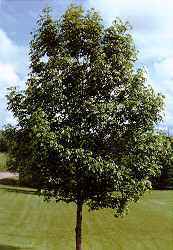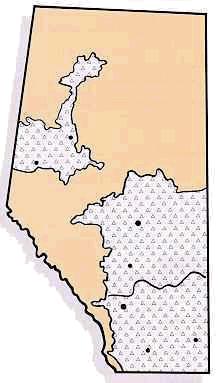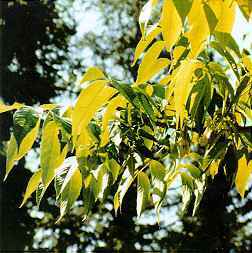| | Plant characteristics | Fall colour | Site preference | Hardiness | Uses | Problems | Insects | Pruning
.

Scientific Name: Fraxinus pennsylvanica Marsh.
Plant Characteristics
Green ash has a straight, single trunk with a high-headed, open crown. Depending on the seed source, some specimens may have droopy branches when mature. Leaves are late to appear in the spring and drop early in the fall. It is easy to transplant.
Green ash can attain a mature height of 12 to 20 m (40 to 65 ft), and a spread of 9 m (30 ft), with an annual growth rate of 10 to 60 cm (4 to 24 in.). It has a useful lifespan of 50 to 90 years.
Bark - Greyish sometimes with orange cast. Tight ridges, shallowly furrowed in an attractive irregular pattern.
Buds - Large, rusty-brown, woolly, set above leaf scar which forms almost a straight line.
Flowers - Dioecious.
Fruit - a one-winged samara 2.5 to 5 cm (1 to 2 in.) long in clusters, shaped like a canoe paddle.
Leaves - Opposite, medium green, odd-pinnate, 5 to 9 leaflets, ovate to ovate-lanceolate. Pubescent beneath. Margin is smooth to faintly irregularly toothed.
Propagated by seed.
Fall Colour
Leaves yellow-brown - not significant since leaves drop so early.
Site Preference
Green ash has a wide soil adaptation, tolerating wet, alkaline, and drought conditions. It should be planted in full sun, but can withstand some shade.
Hardiness
Fully hardy to northern Alberta. It will survive under extreme climate exposure.
.


Uses
Green ash is planted as a street tree, shelterbelt, background, landscape specimen and shade tree.
In shelterbelt situations green ash should be planted l.5 to 3 m (4.5 to 10 ft) between trees in the row and 5 to 8 m (17 to 26 ft) between rows.
Problems
Bark of young trees may sunscald in winter. Female specimens produce samaras which are retained over the winter and give the tree a messy appearance.
Insects
Ash bark beetles in southern Alberta, aphids, gall mites, borers, ash plant bug.
Pruning
Usually develop as single - stemmed trees. Prune in spring to remove dead, diseased or broken branches.
.

Shelterbelts Varieties for Alberta provides information on a number of other trees and shrubs than may be suitable for shelterbelts.
Visit our website directory for the Reforestation Woodlot Listings. |
|